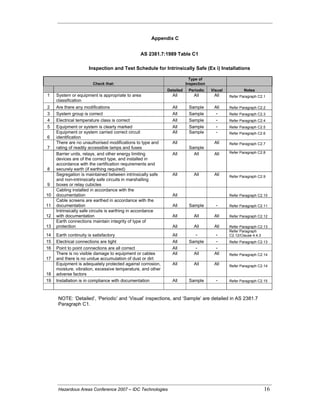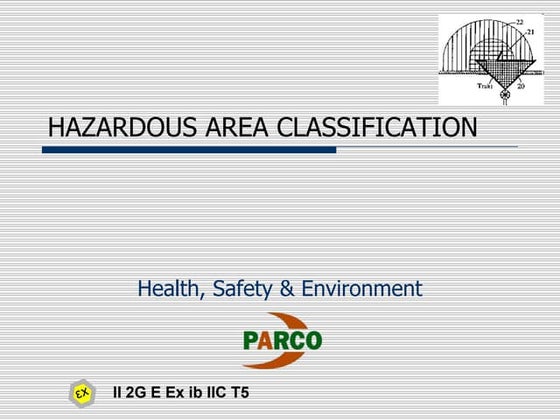Not known Facts About Roar Solutions
Not known Facts About Roar Solutions
Blog Article
Everything about Roar Solutions
Table of ContentsSome Ideas on Roar Solutions You Should KnowTop Guidelines Of Roar SolutionsThe Single Strategy To Use For Roar Solutions
In order to protect installations from a possible explosion a method of analysing and classifying a potentially hazardous area is needed. The objective of this is to make certain the correct option and setup of equipment to ultimately prevent a surge and to make certain safety of life.
(https://profiles.delphiforums.com/n/pfx/profile.aspx?webtag=dfpprofile000&userId=1891249800)
No tools should be installed where the surface temperature of the devices is higher than the ignition temperature of the given risk. Below are some usual dust hazardous and their minimal ignition temperature level. Coal Dirt 380C 225C Polythene 420C (thaws) Methyl Cellulose 420C 320C Starch 460C 435C Flour 490C 340C Sugar 490C 460C Grain Dirt 510C 300C Phenolic Material 530C > 450C Aluminium 590C > 450C PVC 700C > 450C Soot 810C 570C The probability of the threat existing in a focus high adequate to create an ignition will differ from location to area.
In order to identify this threat an installment is split right into areas of risk relying on the amount of time the harmful exists. These areas are referred to as Areas. For gases and vapours and dusts and fibres there are three areas. Area 0 Area 20 A dangerous environment is extremely most likely to be present and may exist for lengthy durations of time (> 1000 hours per year) or perhaps continually Zone 1 Zone 21 A hazardous ambience is feasible yet unlikely to be present for long periods of time (> 10 450 C [842 F] A category of T6 means the minimum ignition temperature is > 85 C [185 F] Dangerous area electric tools possibly developed for usage in greater ambient temperature levels. This would certainly suggested on the ranking plate e.g. EExe II C T3 Ta + 60C( This means at 60C ambient T3 will not be exceeded) T1 T1, T2, T3, T4, T5, T6 T2 T2, T3, T4, T5, T6 T3 T3, T4, T5, T6 T4 T4, T5, T6 T5 T5, T6 T6 T6 A T Class ranking of T1 indicates the optimum surface area temperature created by the instrument at 40 C is 450 C. Thinking the connected T Course and Temperature level score for the devices are proper for the location, you can always make use of an instrument with a more stringent Department rating than needed for the area. There isn't a clear answer to this concern. It really does rely on the sort of tools and what repairs require to be accomplished. Tools with specific examination treatments that can't be performed in the field in order to achieve/maintain 3rd party rating. Have to come back to the factory if it is before the tools's solution. Field Repair Work By Authorised Employee: Challenging testing might not be called for nonetheless particular treatments might require to be followed in order for the equipment to preserve its 3rd party score. Authorized personnel have to be utilized to do the job appropriately Repair work need to be a like for like replacement. New part have to be considered as a direct replacement requiring no special testing of the equipment after the repair is complete. Each item of devices with a harmful rating should be assessed independently. These are described at a high level below, but also for more thorough information, please refer straight to the standards.
The Buzz on Roar Solutions
The tools register is a detailed database of tools records that includes a minimum set of areas to determine each thing's location, technical parameters, Ex-spouse category, age, and ecological information. The proportion of In-depth to Close examinations will certainly be determined by the Tools Danger, which is evaluated based on ignition threat (the likelihood of a source of ignition versus the probability of a combustible ambience )and the unsafe area classification
( Zone 0Area 1, or 2). Implementing a robust Risk-Based Examination( RBI )technique is essential for ensuring conformity and security in handling Electrical Equipment in Hazardous Areas( EEHA).
See This Report about Roar Solutions

In terms of eruptive threat, a harmful location is an environment in which an eruptive atmosphere exists (or might be anticipated to be present) in amounts that need unique preventative measures for the building, setup and use tools. high voltage courses. In this short article we check out the obstacles encountered in the work environment, the threat control steps, and the called for proficiencies to function safely
These compounds can, in particular conditions, develop eruptive ambiences and these can have significant and unfortunate consequences. Most of us are acquainted with the fire triangle get rid of any one of the three aspects and the fire can not happen, yet what does this mean in the context of hazardous locations?
In the majority of instances, we can do little regarding the degrees of oxygen in the air, however we can have substantial impact on sources of ignition, for instance electrical tools. Unsafe locations are documented on the dangerous location category illustration and are determined on-site by the triangular "EX" sign. Below, amongst other vital Click Here info, areas are divided right into three kinds depending upon the risk, the chance and duration that an eruptive atmosphere will exist; Area 0 or 20 is deemed the most unsafe and Zone 2 or 22 is deemed the least.
Report this page